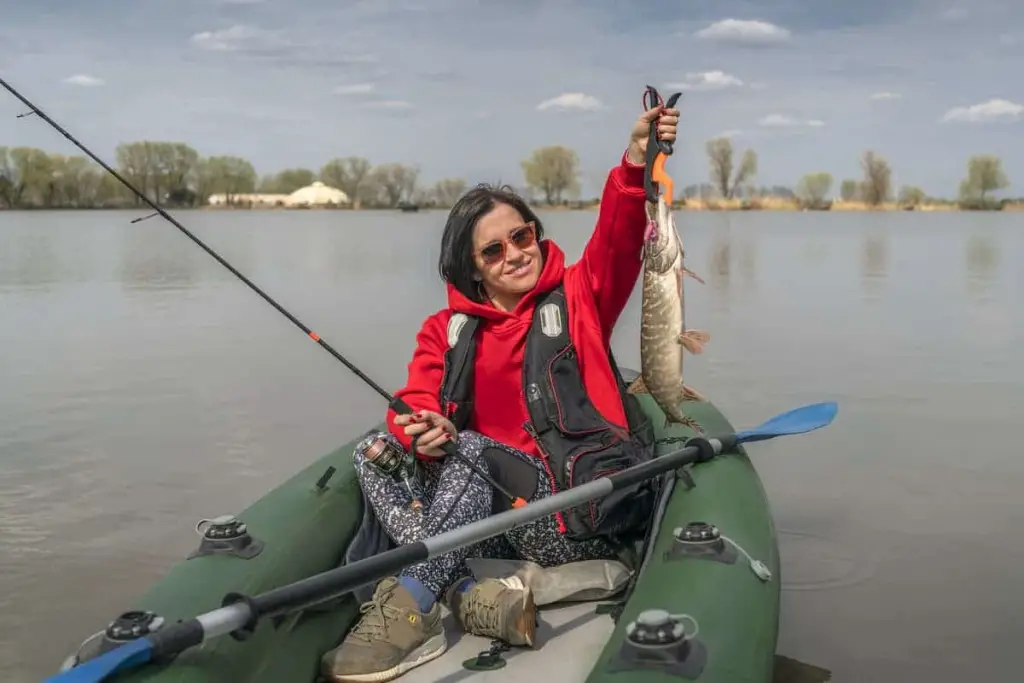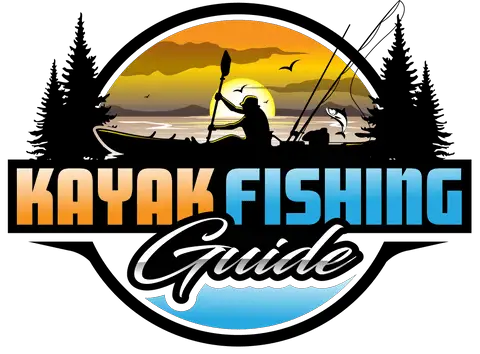You’ll find fishing from a kayak has advantages over fishing from other types of boats! A smaller shadow, less noise, and access to secluded locations, to name a few. However, with less space on a kayak to work with, you may be wondering where you can store fish once you’ve caught them.
When kayak fishing, you can store your fish in the hatch, on the deck, or in the water in a special floating cooler or fish stringer. The best place to keep your fish depends on your kayak, the environment you are fishing in, and the species of fish you are targeting.
In the remainder of this article, we’ll discuss these three different storage options for your fish while kayak fishing and which may be best for different situations.
Where Should You Put the Fish on a Kayak?
Of course, once you have a fish in hand, if you plan on keeping it, it will need to be stored away safely on your small craft. However, where you keep the fish (and the best place for it) will depend on the type of kayak you have.
There are five different types of flat water kayaks: (source)
- Sit-on-Top Recreational
- Sit Inside Recreational
- Touring Kayak
- Inflatable Kayak
- Pedaling Kayak
The best types of kayaks for fishing are mainly Sit-on-Top Recs, Sit-Inside Recs, or the Canoe/Kayak Hybrid. Each kayak is going to have different storage options. Your watercraft may have multiple options that will let you choose your preferred storage method, or your kayak may only let you keep your catch in one place.
Many kayaks can give you the option of keeping fish in one of three places: a hatch, on deck, or in the water in a floating cooler or on a fish stringer.
Of course, where you plan on fishing, and the weather conditions there, will also affect where you may keep your fish.

Hatch Storage
Almost all kayaks have one or two hatches: one on the bow and/or the stern. The hatch can be used for storing an assortment of items, including your fish. If the temperature is cold enough outside, 40°F or lower, you can certainly toss your fish into the hatch. The problem with that, though, is that the inside of your kayak will get slimy and stinky.
To resolve this problem, or if the temperature is too warm, you can purchase a cooler to go into the hatch. You can go all out and buy a hatch cooler, such as the Wilderness Systems Oval Orbix Hatch Cooler, or you can go for the thrifty option and use an insulated grocery bag, such as the one from Veno Bag or your local grocery store.
If you plan to be fishing in temperatures above 40°F, be sure you have something to keep your catch cold in your chosen storage option as well. However, since you want to be mindful of the limited amount of space you have available in your kayak’s hatch, instead of dumping in a bag of ice cubes into the cooler, freeze water in reusable water bottles.
When the ice melts, it will stay in the bottle, and you can stay hydrated. Just be sure to put the water bottles or your fish in a plastic bag to prevent contamination.
Deck Storage
If your kayak is lacking in hatches, or you don’t feel like stretching that far, you can store a cooler on the deck of your kayak. Several great on-deck cooler options are:
- IceMule Coolers Classic – This is a soft-sided cooler that resembles a dry sack. It can be strapped down to any part of your kayak’s deck.
- IceMule Coolers Pro Catch – A step up from the classic, this cooler is built for kayaks. It comes with tie-down clips and bungee webbing.
- Orca Cooler – The Orca is a hard-sided cooler that can sit on the deck of an open style kayak. It comes in a variety of sizes and colors. While it does have a hefty price tag, this is a durable, easy to clean cooler with a lifetime warranty.
- Engel Cooler – Similar to the Orca, but for a lower price, the Engel cooler is hard-sided, and you can choose your size and color.
If you have a sit-inside type of kayak, a soft-sided cooler is a better choice than a hard-sided one. With a soft-sided cooler, you can manipulate the shape and use bungee straps to secure it to the most convenient part of the deck.
If you have flat deck space, you can go with either a soft or hard-sided cooler. The benefit of the hard-sided cooler is your fish are less likely to get bruised if the cooler gets bumped, and they keep cold for longer.
In the Water
Keeping your fish in the water using a fish stringer or on the water in a floating cooler can be an easy, relatively clean way of storing your collection of fish.
- Floating Cooler – These are coolers specifically designed to be pulled behind a man-powered watercraft. The CreekKooler is an excellent choice for floating coolers.
- Fish Stringer – This is the cheapest, cleanest, but the riskiest option for storing fish while kayaking. You can go with a plastic stringer or with a metal clip stringer. To use a stringer on a kayak, you simply:
- Tie a short length of rope to the side or stern of your kayak.
- Tie your stringer to the rope.
- Stick the stringer through the gill and out the mouth of your live catch.
Note: Only place a fish on a fish stringer if you are positive you want to keep it. The stringer goes through the gills and mouth of the fish and can be lethal.
While there are definite pros to “water storage,” besides saving space on your kayak itself and convenience, there is one vital thing to think about: predators.
The fish you are catching are part of a food chain. If you are dangling a string of bluegill through a lake, you might as well be serving a buffet for otters and pike. If you are in saltwater, you need to be aware of sharks, and in the south, there are alligators. A floating cooler, while a bit safer, may still be mistaken for lunch by a large predator.
Think about your location and body of water, then decide if the risk of predators snagging your catch is worth it before you decide on a water storage option for your fish.
Final Thoughts
In conclusion, there are three different storage options for fish on a kayak: in a kayak’s hatch, on the deck, or in the water next to it. Where you decide to keep your fish will depend on the style of your kayak (whether you have a hitch or open deck) as well as the type of weather you’re fishing in (whether you need to use a cooler or not).
Of course, if you do decide a fish you snag turns out not to be a keeper, make sure you know how to return it to the water safely, too. Check out Keep Fish Wet to discover the best catch-and-release practices.
If you like easily to measure the fish you catch on your kayak, be sure to check out this great article on bump boards! Top 3 Bump Boards Explained: A Must-Have for Measuring Fish
Have fun and stay safe out there!
